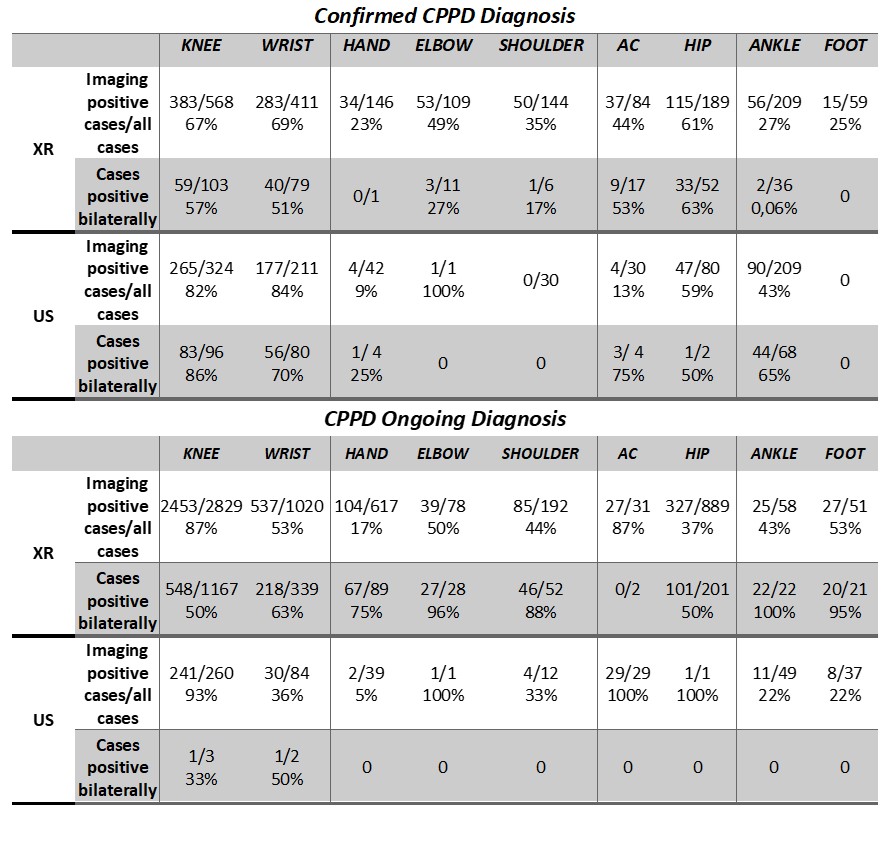Session Information
Session Type: Poster Session A
Session Time: 8:30AM-10:30AM
Background/Purpose: Imaging has been extensively used for the diagnosis of Calcium Pyrophosphate Deposition Disease (CPPD) but the exact prevalence of joint calcifications at imaging in patients with CPPD has not been thoroughly assessed.
This systematic literature review (SLR) is aimed to estimate the prevalence of calcium crystal deposition in peripheral joints by imaging in suspected or definite CPPD patients to establish relevant joints for CPPD monitoring.
Methods: After defining PICOs, Pubmed and Embase were searched from inception to October 2020 for identifying studies that evaluated the application of Conventional Radiography (CR), Ultrasound (US), Computed Tomography (CT) and Dual Energy Computed Tomography (DECT) in detecting calcifications at peripheral joints in patients with defined or probable CPPD diagnosis. Search strategies based on Mesh terms and free text were applied. Six reviewers independently screened the articles. In a first step, the evaluation was based only on titles and abstracts and then, the eligible articles were evaluated in full text for inclusion and data extraction. Prespecified criteria were used for including or excluding the articles.
Results: The SLR identified 1826 manuscripts. 543 papers entered in the full text evaluation and 162 articles were finally included. Regarding the first phase, were excluded 954 abstracts, 352 as duplicate, 156 for the language, 47 for the study type, 171 for the population, 171 for the intervention and 57 for the outcome. During the full text evaluation, were excluded 49 for the unavailability of the full text, 18 as duplicate, 8 for the language, 113 for the study type, 48 for the population, 19 for the intervention and 126 for the outcome. Among included, 36 papers considered patients with definite CPPD with a total population of 1530 patients, 977 cases and 533 controls and 126 papers referred to patients with suspected CPPD with a total population of 30569 patients, 3125 affected by CPPD and 27444 controls.
The results about each joint included are summarized in the table attached (since the low number of studies that evaluated CT and DECT, respectively 7 and 1, the data are not shown). In patients with definite diagnosis, knee and wrist are the joints with the higher prevalence of calcifications at both XR and US, followed by the hip, while in patients with suspected CPPD, the knee is the most prevalent followed by the wrist, hip and shoulder (only sites with more than 50 patients assessed considered). The hand joints have the lowest prevalence of CPPD at imaging. The presence of bilateral imaging findings varies depending on the technique used, the site and the type of patient.
Conclusion: According to the results of this SLR, knees and wrists could be the sentinel joints for CPPD detection by imaging.
To cite this abstract in AMA style:
Adinolfi A, Sirotti S, Sakellariou G, Cipolletta E, Filippucci E, Porta F, Sarzi-Puttini P, Scire C, Keen H, Mandl P, Pineda C, Terslev L, D'Agostino M, Damjanov N, Iagnocco A, Filippou G. Assessing Relevant Joints for Monitoring CPPD Diseases: A Systematic Literature Review of Imaging Techniques by the OMERACT Ultrasound – CPPD Subgroup [abstract]. Arthritis Rheumatol. 2021; 73 (suppl 9). https://acrabstracts.org/abstract/assessing-relevant-joints-for-monitoring-cppd-diseases-a-systematic-literature-review-of-imaging-techniques-by-the-omeract-ultrasound-cppd-subgroup/. Accessed .« Back to ACR Convergence 2021
ACR Meeting Abstracts - https://acrabstracts.org/abstract/assessing-relevant-joints-for-monitoring-cppd-diseases-a-systematic-literature-review-of-imaging-techniques-by-the-omeract-ultrasound-cppd-subgroup/

